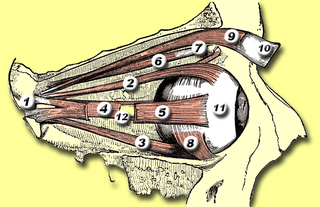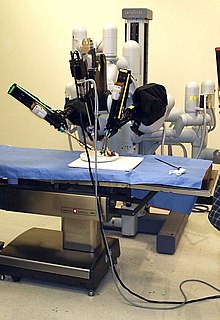
Surgery is a medical or dental specialty that uses operative manual and instrumental techniques on a person to investigate or treat a pathological condition such as a disease or injury, to help improve bodily function, appearance, or to repair unwanted ruptured areas.

Esophageal achalasia, often referred to simply as achalasia, is a failure of smooth muscle fibers to relax, which can cause the lower esophageal sphincter to remain closed. Without a modifier, "achalasia" usually refers to achalasia of the esophagus. Achalasia can happen at various points along the gastrointestinal tract; achalasia of the rectum, for instance, may occur in Hirschsprung's disease. The lower esophageal sphincter is a muscle between the esophagus and stomach that opens when food comes in. It closes to avoid stomach acids from coming back up. A fully understood cause to the disease is unknown, as are factors that increase the risk of its appearance. Suggestions of a genetically transmittable form of Achalasia exist, but this is neither fully understood, nor agreed upon.
Heller myotomy is a surgical procedure in which the muscles of the cardia are cut, allowing food and liquids to pass to the stomach. It is used to treat achalasia, a disorder in which the lower esophageal sphincter fails to relax properly, making it difficult for food and liquids to reach the stomach.

Eye surgery, also known as ocular surgery, is surgery performed on the eye or its adnexa, typically by an ophthalmologist. The eye is a very fragile organ, and requires extreme care before, during, and after a surgical procedure to minimise or prevent further damage. An expert eye surgeon is responsible for selecting the appropriate surgical procedure for the patient, and for taking the necessary safety precautions. Mentions of eye surgery can be found in several ancient texts dating back as early as 1800 BC, with cataract treatment starting in the fifth century BC. Today it continues to be a widely practiced type of surgery, with various techniques having been developed for treating eye problems.

Oculopharyngeal muscular dystrophy (OPMD) is a rare form of muscular dystrophy with symptoms generally starting when an individual is 40 to 50 years old. It can be autosomal dominant neuromuscular disease or autosomal recessive. The most common inheritance of OPMD is autosomal dominant, which means only one copy of the mutated gene needs to be present in each cell. Children of an affected parent have a 50% chance of inheriting the mutant gene.

A surgical instrument is a tool or device for performing specific actions or carrying out desired effects during a surgery or operation, such as modifying biological tissue, or to provide access for viewing it. Over time, many different kinds of surgical instruments and tools have been invented. Some surgical instruments are designed for general use in all sorts of surgeries, while others are designed for only certain specialties or specific procedures. Accordingly, the nomenclature of surgical instruments follows certain patterns, such as a description of the action it performs, the name of its inventor(s), or a compound scientific name related to the kind of surgery.

The inferior oblique muscle or obliquus oculi inferior is a thin, narrow muscle placed near the anterior margin of the floor of the orbit. The inferior oblique is one of the extraocular muscles, and is attached to the maxillary bone (origin) and the posterior, inferior, lateral surface of the eye (insertion). The inferior oblique is innervated by the inferior branch of the oculomotor nerve.

Johann Friedrich Dieffenbach was a German surgeon. He was born in Königsberg and died in Berlin.

Robotic surgery are types of surgical procedures that are done using robotic systems. Robotically-assisted surgery was developed to try to overcome the limitations of pre-existing minimally-invasive surgical procedures and to enhance the capabilities of surgeons performing open surgery.
Esophageal spasm is a disorder of motility of the esophagus.

Strabismus surgery is surgery on the extraocular muscles to correct strabismus, the misalignment of the eyes. Strabismus surgery is a one-day procedure that is usually performed under general anesthesia most commonly by either a neuro- or pediatric ophthalmologist. The patient spends only a few hours in the hospital with minimal preoperative preparation. After surgery, the patient should expect soreness and redness but is generally free to return home.
Mucotomy is a surgical procedure of excising the mucous membrane from an organ. This is done as part of several gastrointestinal surgeries, such as antireflux mucosectomy for the treatment of Barrett's esophagus, colectomy for treating various intestinal disorders, and per-oral endoscopic myotomy for treatment of achalasia.

Myotomys is a genus of African Karoo rats that inhabit the Karoo, a semi-desert region in the southern portion of the African continent. Previously placed in the genus Otomys, they are sometimes referred to as vlei rats.
Cricopharyngeal myotomy is a surgical sectioning of the cricopharyngeus muscle, also known as the upper esophageal sphincter, that has been advocated for the treatment of cricopharyngeal spasm, or cricopharyngeal achalasia, that leads to cervical dysphagia in the clinical setting.
Hyoid suspension, also known as hyoid myotomy and suspension or hyoid advancement, is a surgical procedure or sleep surgery in which the hyoid bone and its muscle attachments to the tongue and airway are pulled forward with the aim of increasing airway size and improving airway stability in the retrolingual and hypopharyngeal airway. The horseshoe shaped hyoid bone sits directly below the base of tongue with the arms of the bone flanking the airway. Hyoid suspension is typically performed as a treatment for obstructive sleep apnea (OSA). This procedure is frequently performed with a uvulopalatopharyngoplasty (UPPP) which targets sites of obstruction higher in the airway. Typically, a hyoid suspension is considered successful when the patient's apnea-hypopnea index is significantly reduced after surgery.
Thoguluva Shesadri Chandrasekar is an Indian gastroenterologist and the founder chairman of Medindia Hospitals, a healthcare facility based in Chennai. He is credited with the performance of over 23,000 endoscopy procedures and is known for the Braille chart on personal hygiene he prepared in 2015 for the visually impaired people. The Government of India awarded him the fourth highest civilian honour of the Padma Shri, in 2016, for his contributions to medicine.

Morio Kasai was a Japanese surgeon who had a strong interest in pediatric surgery. While Kasai went into practice at a time when pediatric surgery was not an established subspecialty, much of his clinical and research work was related to the surgical care of children. He is best known for devising a surgical procedure, the hepatoportoenterostomy, to address a life-threatening birth defect known as biliary atresia. The modern form of the operation is still known as the Kasai procedure.










